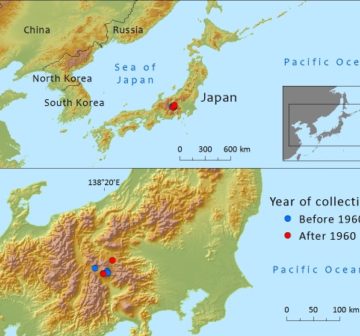Pinaceae
Picea koyamae
Endemic to Central Honshu in Japan where a population of less than 1000 individuals occur on two mountains; extensive historic logging has now led to severe fragmentation
References and further reading
- Akashi, K. (2006). Microtopography, debris flow deposits and forest vegetation on the floodplains in the upper stream of the Todai River, northwestern Akaishi Mountains. Natural History Report Inadani 7: 33–78.
- Hayashi,Y. (1960). Notes on Japanese trees and shrubs. Bulletin of the Government Forest Experiment Station 125: 71–74.
- Katsuki, K. & Seido, K. (1999). Populations of P. koyamae and P. maximowiczii in Hakushu-sho, Yamanashi Prefecture. Transaction of the Kanto Japanese Forestry Society 50: 69–70.
- Katsuki, T., Aizawa, M., Akashi, K., Shimada, K. & Shimada, K. (2005). Present conditions of Picea koyamae and P. maximowiczii in Ohshika Village, Nagano Prefecture. Two threatened plant species at the southern limit of distribution (in Japanese). Natural History Report Inadani 6: 71-76.
- Katsuki, T., Akashi, K., Tanaka, S., Iwamoto, K. & Tanaka, N. (2008). An estimation of the present distribution of Picea koyamae and P. maximowiczii using climatic and geological factors. Japanese Journal of Forest Environment 50: 25-34.
- Katsuki, T., Shimada, K. & Yoshimaru, H. (2010). Process to extinction and genetic structure of a threatened Japanese conifer species, Picea koyamae. Journal of Forest Research: DOI: 10.1007/s10310-010-0227-4.
- Katsuki, T. & Gardner, M. (2011). Picea koyamae. In: IUCN 2012. IUCN Red List of Threatened Species. Version 2012.2. . Downloaded on 11 November 2012.
- Katsuki, T., Sugaya, T., Kitamura, K., Takeuchi, T., Katsuta, M. & Yoshimaru, H. (2004). Geographic Distribution and Genetic Variation of a Vulnerable Conifer Species, Picea koyamae (Pinaceae). Acta Phytotaxonomica et Geobotanica. 55(1): 19-28.
- Note, H., Okitsu, S. & Momahara, A. (1999). Habitat of Picea koyamai Shirasawa and P. maximowiczii Regel ex mart. in Japan. Journal of Japanese Foresty Science 81: 236-244.
- Shimizu, T, (1992). Taxonomy and phytogeography of conifers, with special reference to some subalpine genera. The genus Picea. Japanese Journal of Historical Botany 9: 3-11.
- Shirasawa, Y. & Koyama, M. (1913). Some new species of Picea and Abies in Japan. The Botanical Magazine Tokyo 27: 127-131.





